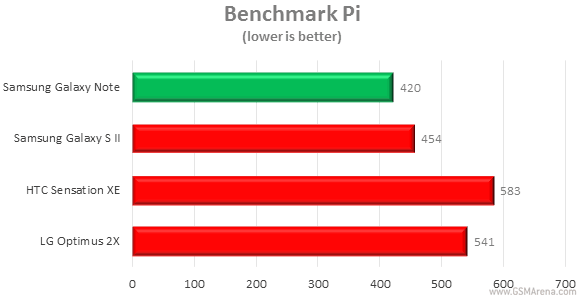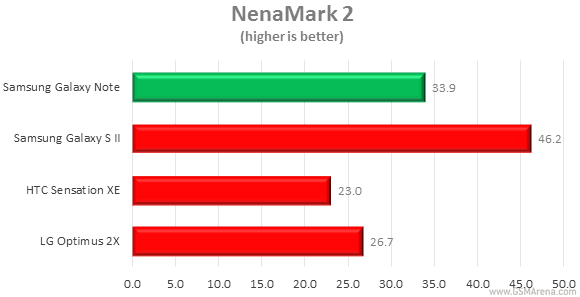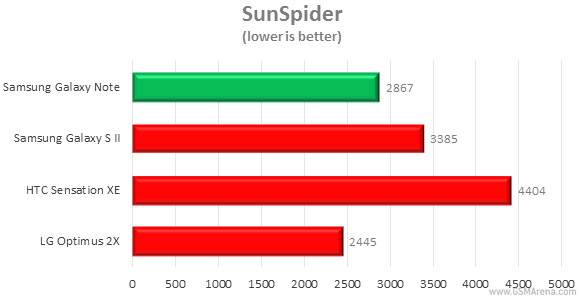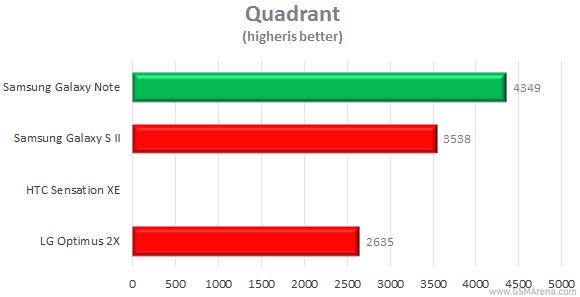Samsung Galaxy Note N7000 review: Power play
Power play
Performance benchmarks are promising
Armed with a couple of ARM Cortex-A9 CPU cores, clocked at the respectable 1.4GHz, and the Mali-400MP GPU, we wouldn’t expect the Samsung Galaxy Note to be anything short of a benchmark buster. As we'll see in a moment it didn’t disappoint - always placing at the top or right below it. And that is despite the HD resolution, which means that the Note needs to refresh 167% more pixels than its WVGA competitors, and 98% more than the qHD smartphones.
To put the Note Exynos chipset performance into context, we chose to compare it to some of the most powerful competitors. Recently updated to Gingerbread, the LG Optimus 2X will be defending the Tegra 2 cause, the HTC Sensation XE will be fighting under the Qualcomm Snapdragon flag, while the Galaxy S II, will try and answer if the increase in clock speed is enough to compensate for the higher resolution.
We started with BenchmarkPi, which is set to test the pure calculating power of each CPU. Unsurprisingly, the Note took the crown here as it has the highest clock speed of the Cortex-A9 gang. The Sensation XE offers the CPU with the highest clock of the bunch, but it uses the older Scorpion architecture, so it’s unable to pose a real challenge here.

The other CPU-only benchmark we did was Linpack and we saw a similar picture. With all competitors employing dual-core architectures, we went for the multi-threaded version of the benchmark. The Note beat its competitors quite comfortably, achieving more than twice the score of the Sensation XE.

We then moved on to the GPUs and ran NenaMark 2 on the four smartphones. The Note ended up only second best here, which is still quite an achievement. The Galaxy S II had it easy as it has the same GPU as its bigger brother and took advantage of its lower resolution to beat it. The Note still managed to score better than the Optimus 2X and the Sensation XE though.

The next two benchmarks were browser-related and were set to test the JavaScript performance, as well as the CPUs of the contenders. The Samsung Galaxy Note was already seeing itself as the winner here, after beating the previous leader – Galaxy S II, but the Optimus 2X put in a fresh challenge after its Gingerbread update and ended up on top.

BrowserMark came in next and saw the Samsung Galaxy Note concede its first defeat. The Note did about as good as the Galaxy S II, but that was some way off the pace set by the Optimus 2X and the Sensation XE.

Unfortunately, by the time we run the last benchmark on the Galaxy Note, the Sensation XE was no longer around so it won’t be represented. Still, even if it was it wouldn’t be able to come anywhere near the Galaxy Note score of 4349. Some way to dethrone the Galaxy S II.

Obviously, the Samsung Galaxy Note is one hell of a powerhouse and there’s little to worry about in terms of future proofing. It can easily beat or at least match every single one of the current crop of droid flagships in terms of processing power, so you can rest assured that it will be offering you all the performance you need.
Now let’s see if the user interface is as feature-rich as it is fast.
Reader comments
- Anonymous
- 18 Nov 2020
- fs}
Check for update and do it
- kianoush
- 17 Jan 2020
- amF
nice memorial gift of friends and excellent phone, I still have it in use ,Thanks samsung
- Javier
- 20 Dec 2019
- Pbv
excellent phone, I still have it in use...